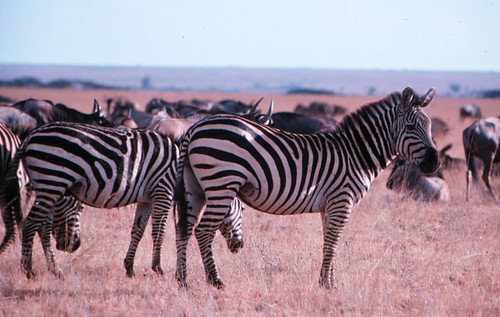Zebra and wildebeest in Kenya’s Masai Mara Game Reserve (photo credit: ILRI/Elsworth).
The New York Times and other media are reporting this week that one of the greatest wildlife spectacles on earth—the annual migration of nearly 2 million wildebeest and zebra from the drying savannas of the Serengeti, in Tanzania, to the wetter, greener, pastures of Kenya’s adjacent Masai Mara, and back again—is threatened by a proposed new national transit road for northern Tanzania that would cut right across the migration route of these vast herds of ungulates, likely leading to the collapse of this migration and possibly the crash of this ecosystem as a whole.
Kenya’s Masai Mara is the only year-round water source in the Greater Serengeti, and thus serves as critical dry-season grazing grounds for these vast herds of big mammals.
Just one of the problems such a road would bring is a greater disease burden to people, livestock and wildlife alike. In her extensive and useful research notes to her recent article, ‘Road Kill in the Serengeti’, in the New York Times, Olivia Judson refers readers to a scientific paper written by Eric Fevre, of the Zoonotic and Emerging Diseases research group at the University of Edinburgh, now based at the International Livestock Research Institute (ILRI) in Kenya while working on a 3-year human-animal disease research project in Busia District. Fevre describes the spread of animal diseases through animal transportation in his article, ‘Animal movements and the spread of infectious diseases’ (Trends in Microbiology, 2006).
Perhaps just in time, just this month former ILRI ecologist Robin Reid, now director of the Center for Collaborative Conservation at Colorado State University, in Fort Collins, USA, began a project in Kenya that is putting radio collars on wildebeest to learn more precisely what routes the animals take in their migration. This project’s members are involving Maasai schoolchildren, who are naming the wildebeest, which they will then be able to follow. The wildebeest collars send regular tracking signals to Safaricom, which are then sent to Colorado, where the routes are posted on a web map that the schoolchildren can follow.
This year’s annual wildebeest migration has already begun. Herds are reported to have crossed the common border of Kenya/Tanzania from Northern Serengeti into Masai Mara, about 4 days ago. ‘What has been unusual about this year’s migration,’ says Paul Kirui, in the Masai Mara, ‘is that the main migration from the south arrived in the Mara early ahead of the Loita herds—the Kenyan resident herds of wildebeest—which usually migrate into the Mara from the east of the park. Normally when we start seeing them move into the park, it is a sign that the main migration from the south is on the way.’
The first population of wildebeest that Reid’s team darted and then tagged with radio collars in the Mara is the Loita group that remains resident in Kenya all year round. Or so the researchers think. The radio collars, now fixed on the first 15 wildebeest, have already started to report back and will be letting scientists, and those schoolchildren, know just where they go, and when.
Reid’s return gave ILRI cause to revisit two remarkable films about her ILRI research in the Mara. Counting in a Disappearing Land (ILRI, 11 minutes, 2007) describes Reid’s project with a Maasai community that has traditionally herded their livestock in Kenya’s wildlife-rich Masai Mara region. This ILRI project was looking to find ways of balancing the needs of people, lands and wildlife. In The Great Migration (CBS ’60 Minutes’, 15 minutes, October 2009), Scott Pelley interviews Reid about the threats to this natural spectacle and the part local Masai are playing to address these threats.
Collaborative conservation may indeed be the answer to saving the Serengeti ecosystem. Protecting majestic wild places and the wildlife they support, places that instill wonder in us, matters, of course, but so does protecting millions of people from severe poverty, chronic hunger and the afflictions that come in their wake: disease and untimely death.
With a large percentage of its land area under protection, Tanzania is a world leader in biodiversity conservation. It is also very, very poor. How this tug at resources—whether the Serengeti Plains will be used for wildlife tourism or other kinds of commerce—will play out may depend on how much the local communities living in poverty near the wildlife benefit from saving this, the last of the great migrations of big mammals on Earth.
More . . . (New York Times, 15 June 2010)
An alternative, southern road in Tanzania is discussed on a webpage of the Frankfurt Zoological Society.
See Paul Kirui’s blog on 17 June 2010 the migration on Masai Mara Updates.

